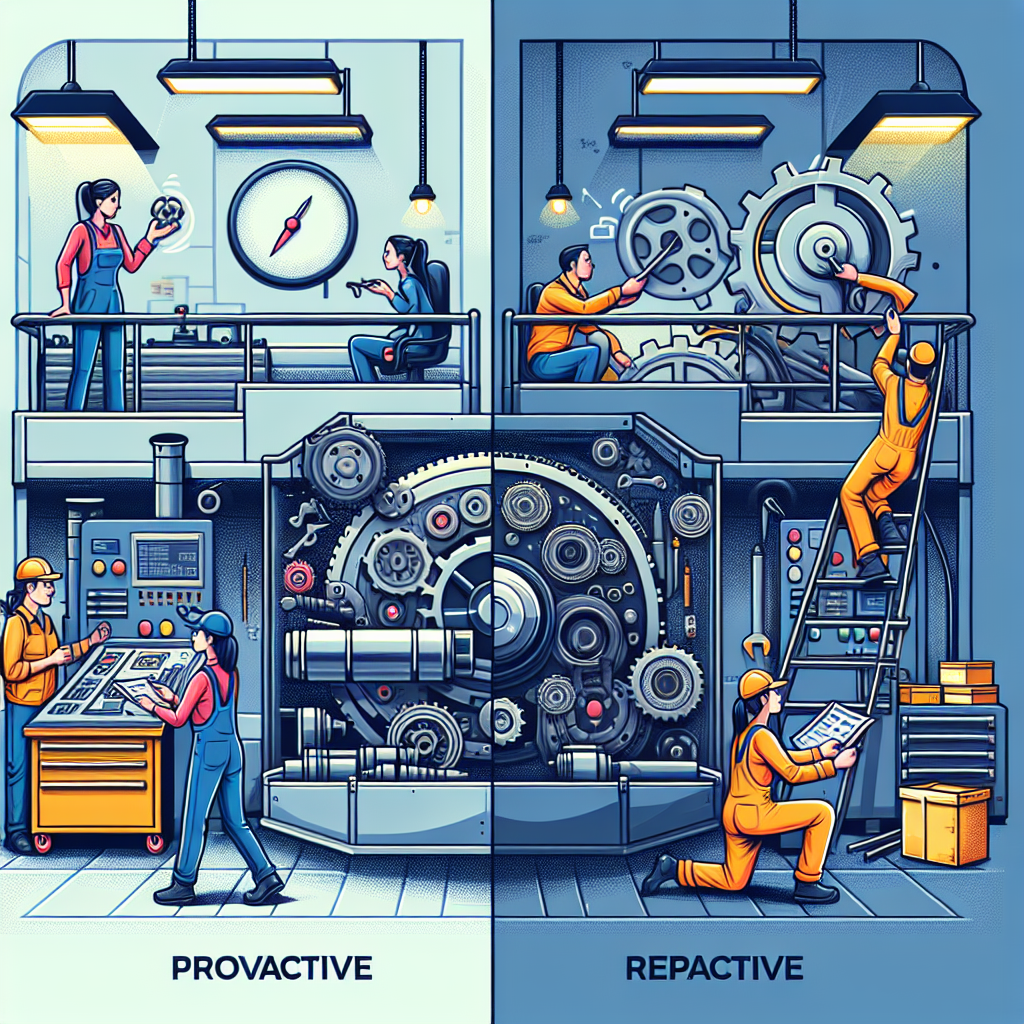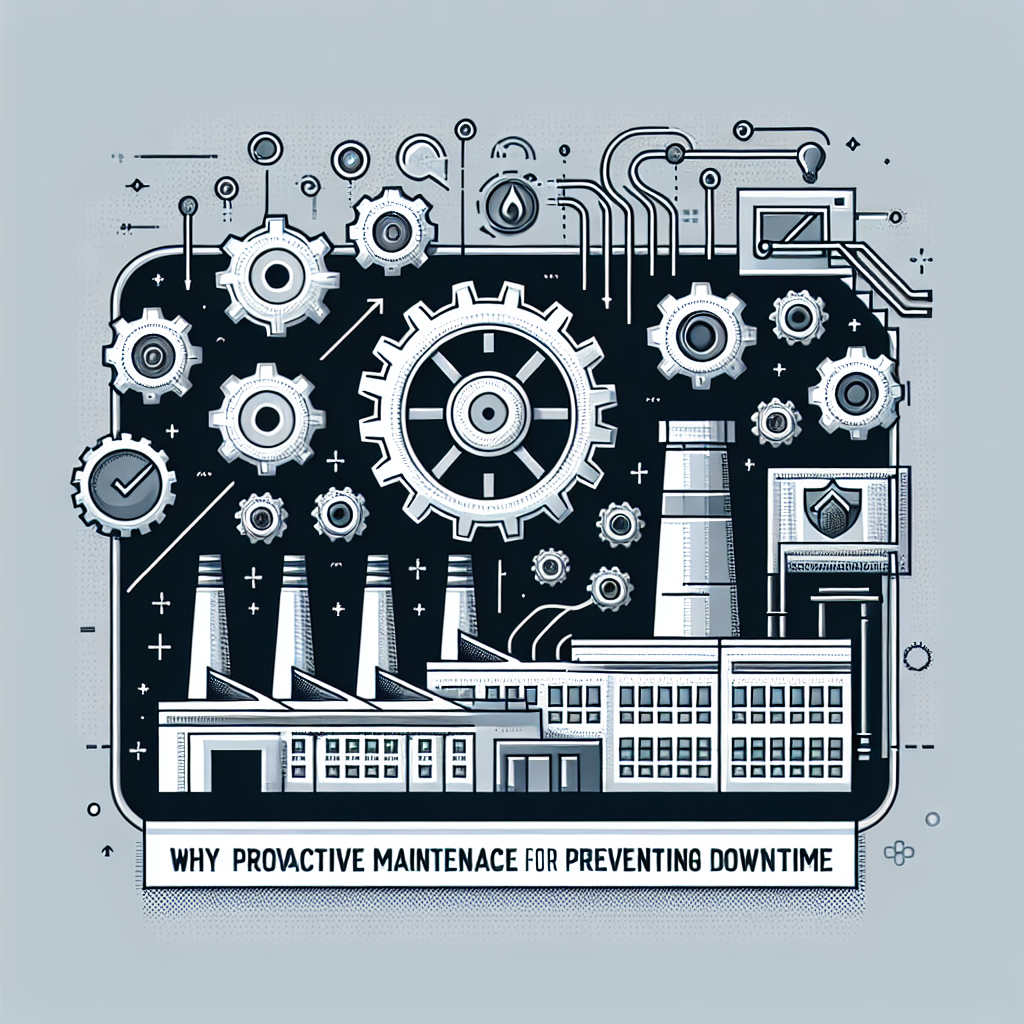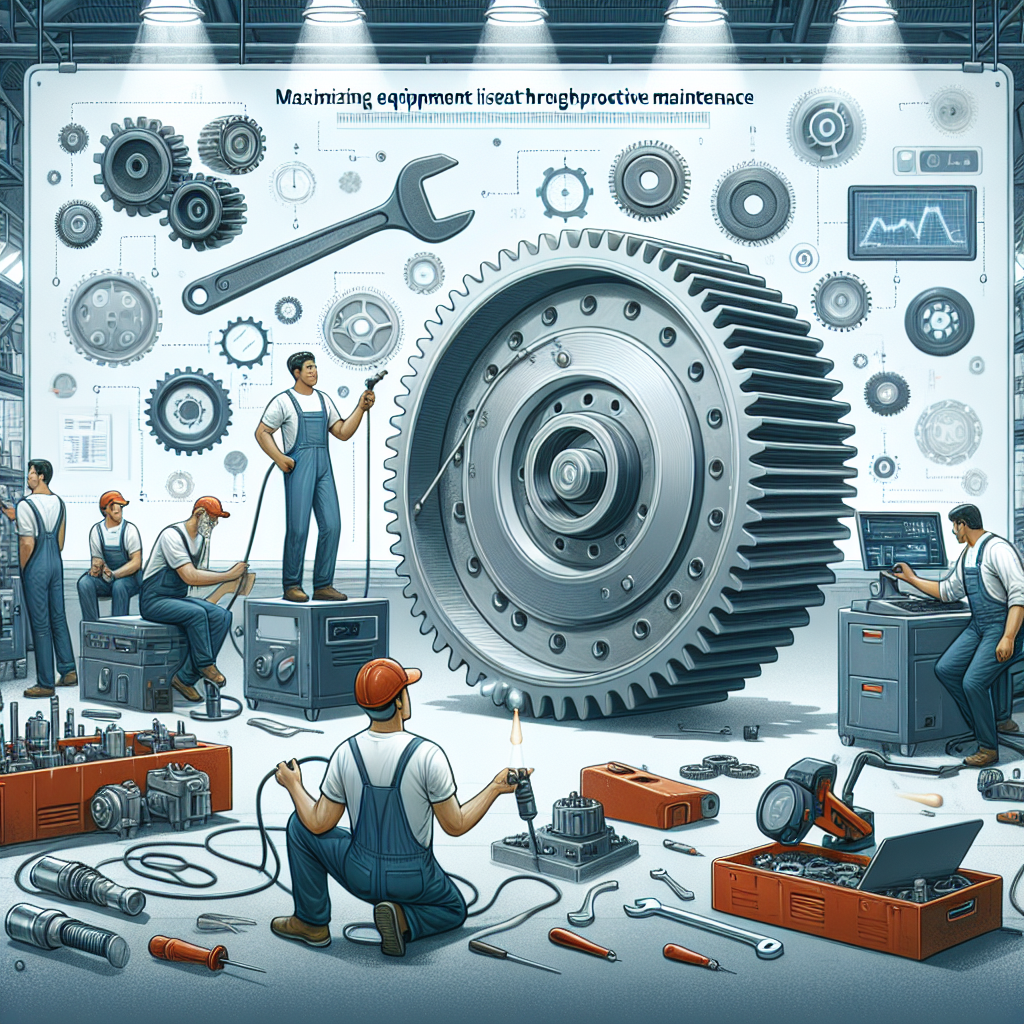Your cart is currently empty!
Tag: Maintenance

The Evolution of Managed Services: From Break/Fix to Proactive Maintenance
Managed services have come a long way since the days of break/fix IT support. In the past, companies would only call in IT support when something went wrong, leading to costly downtime and lost productivity. However, with the evolution of technology and the increasing complexity of IT systems, proactive maintenance has become the new standard in managed services.Proactive maintenance involves monitoring, managing, and maintaining IT systems on an ongoing basis to prevent issues before they occur. This shift from reactive to proactive maintenance has revolutionized the way businesses manage their IT infrastructure, leading to increased efficiency, reduced downtime, and improved overall performance.
One of the key benefits of proactive maintenance is the ability to identify and address potential issues before they become major problems. By continuously monitoring IT systems, managed service providers can detect early warning signs of hardware failures, software glitches, or security vulnerabilities and take corrective action before they escalate. This proactive approach not only minimizes downtime but also helps businesses avoid costly repairs and data loss.
Another advantage of proactive maintenance is its focus on optimization and performance improvement. Managed service providers can analyze data, identify trends, and make recommendations for optimizing IT systems to increase efficiency and productivity. This proactive approach ensures that businesses are getting the most out of their technology investments and staying ahead of the competition.
In addition to proactive maintenance, managed service providers also offer a range of other services to help businesses manage their IT infrastructure more effectively. These services may include network monitoring, security management, data backup and recovery, and software updates. By outsourcing these tasks to a managed service provider, businesses can free up internal resources, reduce costs, and focus on their core business activities.
Overall, the evolution of managed services from break/fix to proactive maintenance has transformed the way businesses manage their IT infrastructure. By taking a proactive approach to IT support, businesses can minimize downtime, improve performance, and stay ahead of the competition. With the increasing complexity of IT systems and the constant threat of cyber attacks, proactive maintenance has become essential for businesses of all sizes. If you haven’t already, now is the time to consider partnering with a managed service provider to take advantage of the benefits of proactive IT support.

Measuring the ROI of Proactive Maintenance Initiatives
Proactive maintenance initiatives are essential for ensuring the smooth operation of equipment and machinery in any organization. By taking a proactive approach to maintenance, businesses can prevent costly breakdowns, minimize downtime, and extend the lifespan of their assets. However, measuring the return on investment (ROI) of these initiatives can be challenging. In this article, we will discuss some key metrics and methods for measuring the ROI of proactive maintenance initiatives.One of the most straightforward ways to measure the ROI of proactive maintenance initiatives is to compare the costs of implementing these initiatives with the savings they generate. This can include factors such as reduced maintenance costs, decreased downtime, and increased productivity. By calculating the difference between these costs and savings, businesses can determine the overall ROI of their proactive maintenance efforts.
Another important metric to consider when measuring the ROI of proactive maintenance initiatives is asset reliability. By tracking the reliability of assets before and after implementing proactive maintenance measures, businesses can quantify the impact of these initiatives on the overall performance of their equipment. Increased asset reliability can lead to improved productivity, reduced downtime, and higher customer satisfaction, all of which contribute to a positive ROI.
Additionally, businesses can measure the ROI of proactive maintenance initiatives by looking at key performance indicators (KPIs) such as mean time between failures (MTBF), mean time to repair (MTTR), and overall equipment effectiveness (OEE). By tracking these KPIs over time, businesses can assess the effectiveness of their proactive maintenance efforts and make data-driven decisions to optimize their maintenance strategies.
Furthermore, businesses can use advanced analytics tools and software to analyze data related to their proactive maintenance initiatives. By leveraging predictive maintenance technologies, businesses can identify potential issues before they occur, prioritize maintenance tasks, and optimize maintenance schedules. This can lead to significant cost savings, increased asset reliability, and a higher ROI for proactive maintenance initiatives.
In conclusion, measuring the ROI of proactive maintenance initiatives is essential for demonstrating the value of these efforts to stakeholders and decision-makers within an organization. By considering factors such as cost savings, asset reliability, KPIs, and advanced analytics, businesses can quantify the impact of their proactive maintenance initiatives and make informed decisions to improve their maintenance strategies. Ultimately, proactive maintenance initiatives are a valuable investment for any organization looking to optimize the performance of their assets and maximize their ROI.

Implementing Predictive Maintenance as Part of a Proactive Maintenance Approach
Predictive maintenance is a proactive maintenance strategy that leverages data and analytics to predict when equipment is likely to fail so that maintenance can be performed just in time. This approach helps organizations reduce downtime, minimize maintenance costs, and extend the lifespan of their assets.Implementing predictive maintenance as part of a proactive maintenance approach requires careful planning and execution. Here are some key steps to consider:
1. Data collection and analysis: The first step in implementing predictive maintenance is to collect and analyze data from sensors, equipment, and other sources. This data can include information on temperature, vibration, pressure, and other key indicators of equipment health. By analyzing this data, organizations can identify patterns and trends that indicate when maintenance is needed.
2. Selecting the right technology: There are various technologies available for implementing predictive maintenance, including vibration analysis, infrared thermography, ultrasound testing, and oil analysis. It is important to select the right technology for your specific equipment and maintenance needs. Consider factors such as cost, accuracy, and ease of implementation when choosing a technology.
3. Setting up a monitoring system: Once the technology is selected, it is important to set up a monitoring system that continuously collects and analyzes data from equipment. This system should be able to alert maintenance teams when a potential issue is detected so that they can take corrective action before a failure occurs.
4. Training and education: Implementing predictive maintenance requires a skilled workforce that understands how to use the technology and interpret the data. Providing training and education to maintenance teams is essential for the success of the program. Consider investing in training programs or partnering with experts in predictive maintenance to ensure that your teams are equipped to effectively use the technology.
5. Continuous improvement: Predictive maintenance is an ongoing process that requires continuous monitoring, analysis, and improvement. Regularly review the performance of the predictive maintenance program and make adjustments as needed to optimize its effectiveness. This may include refining data collection processes, updating technology, or expanding the program to cover additional equipment.
In conclusion, implementing predictive maintenance as part of a proactive maintenance approach can help organizations improve equipment reliability, reduce downtime, and increase operational efficiency. By following these key steps and investing in the right technology and training, organizations can successfully implement predictive maintenance and realize the benefits of a proactive maintenance strategy.

Proactive vs. Reactive Maintenance: The Case for Proactive Strategies
Maintenance is an essential aspect of any business operation, ensuring that equipment and facilities are running smoothly and efficiently. When it comes to maintenance strategies, two approaches are commonly employed: proactive and reactive maintenance.Reactive maintenance is a traditional approach where repairs are only carried out after a piece of equipment or machinery has already broken down. This can lead to costly downtime, unexpected expenses, and disruptions to production schedules. On the other hand, proactive maintenance involves regularly scheduled inspections, preventative maintenance, and predictive maintenance techniques to prevent breakdowns before they occur.
There are several advantages to implementing a proactive maintenance strategy over a reactive one. One of the key benefits is cost savings. By regularly inspecting and maintaining equipment, businesses can identify and address issues before they escalate into major problems. This can help avoid costly repairs, replacements, and downtime, ultimately saving money in the long run.
Proactive maintenance can also improve equipment reliability and longevity. By keeping equipment in optimal condition, businesses can extend the lifespan of their assets and reduce the need for frequent repairs or replacements. This can improve overall efficiency, productivity, and performance, leading to a more reliable operation.
Additionally, proactive maintenance can help businesses better plan and schedule maintenance activities. By conducting regular inspections and monitoring equipment performance, businesses can identify trends and patterns that can help them anticipate maintenance needs and plan ahead. This can help minimize disruptions to production schedules and ensure that maintenance activities are carried out in a timely manner.
Furthermore, proactive maintenance can enhance safety in the workplace. By regularly inspecting and maintaining equipment, businesses can identify and address potential safety hazards before they pose a risk to employees. This can help create a safer work environment and reduce the likelihood of accidents and injuries.
In conclusion, while reactive maintenance may seem like a cost-effective approach in the short term, the benefits of proactive maintenance far outweigh the drawbacks. By implementing a proactive maintenance strategy, businesses can save money, improve equipment reliability, increase productivity, and enhance safety in the workplace. Ultimately, proactive maintenance is a smart investment that can help businesses achieve long-term success and sustainability.

Why Proactive Maintenance is Essential for Preventing Downtime
In today’s fast-paced business environment, downtime can be a major setback for any organization. Whether it’s a manufacturing plant, a data center, or an office building, downtime can result in lost productivity, revenue, and customer satisfaction. That’s why proactive maintenance is essential for preventing downtime and keeping operations running smoothly.Proactive maintenance involves taking a proactive approach to maintaining equipment and facilities before any issues arise. This can include regular inspections, scheduled maintenance tasks, and monitoring systems to detect potential problems before they escalate. By being proactive in maintenance efforts, organizations can avoid unexpected breakdowns, reduce repair costs, and extend the lifespan of their equipment.
One of the key benefits of proactive maintenance is the prevention of downtime. By identifying and addressing potential issues early on, organizations can avoid costly interruptions to their operations. For example, a manufacturing plant that regularly inspects its machinery and replaces worn parts can prevent a breakdown that could halt production for days or even weeks.
Proactive maintenance also helps improve overall equipment reliability. By implementing a proactive maintenance program, organizations can reduce the likelihood of unexpected equipment failures and extend the lifespan of their assets. This can result in increased productivity, reduced downtime, and lower maintenance costs in the long run.
In addition to preventing downtime, proactive maintenance can also improve workplace safety. By regularly inspecting equipment and facilities, organizations can identify and address potential safety hazards before they cause harm to employees. This can help create a safer work environment and reduce the risk of accidents and injuries.
Overall, proactive maintenance is essential for preventing downtime and ensuring the smooth operation of any organization. By taking a proactive approach to maintenance, organizations can avoid costly interruptions, improve equipment reliability, and enhance workplace safety. Investing in proactive maintenance efforts can ultimately lead to increased productivity, reduced costs, and a more efficient operation.

Case Study: The Success of Proactive Maintenance in Industry
In today’s fast-paced industrial environment, the importance of proactive maintenance cannot be overstated. By implementing a proactive maintenance strategy, companies can prevent costly breakdowns, minimize downtime, and ensure that their equipment is operating at peak efficiency. One industry that has seen significant success with proactive maintenance is the manufacturing sector.A case study conducted on a manufacturing plant that implemented proactive maintenance found that the plant was able to reduce maintenance costs by 25% and increase equipment uptime by 20%. These impressive results can be attributed to the plant’s shift from a reactive maintenance approach to a proactive one.
Under the reactive maintenance model, equipment failures were addressed only after they occurred, leading to costly repairs and unplanned downtime. In contrast, proactive maintenance involves regularly scheduled inspections, preventive maintenance tasks, and predictive maintenance techniques to identify and address potential issues before they escalate into major problems.
By implementing a proactive maintenance program, the manufacturing plant was able to identify and address issues such as worn-out parts, lubrication deficiencies, and equipment malfunctions before they caused costly breakdowns. This proactive approach not only reduced maintenance costs but also increased equipment reliability and extended the lifespan of the plant’s machinery.
In addition to cost savings and increased uptime, proactive maintenance also allows companies to better plan and schedule maintenance activities, leading to improved overall operational efficiency. By conducting regular inspections and maintenance tasks, companies can optimize their equipment performance, minimize the risk of unexpected breakdowns, and ensure that their production processes run smoothly.
Overall, the success of proactive maintenance in the manufacturing industry demonstrates the significant benefits of adopting a proactive approach to maintenance. By investing in regular inspections, preventive maintenance tasks, and predictive maintenance techniques, companies can reduce costs, increase uptime, and improve overall operational efficiency. As technology continues to advance, proactive maintenance will become increasingly important for companies looking to stay competitive in today’s rapidly changing industrial landscape.

Maximizing Equipment Lifespan Through Proactive Maintenance
Proactive maintenance is a key strategy in maximizing the lifespan of equipment in any industry. By implementing regular maintenance schedules and inspections, businesses can prevent costly breakdowns and extend the life of their equipment. This approach not only saves money in the long run but also improves efficiency and overall productivity.One of the main benefits of proactive maintenance is that it allows businesses to identify potential issues before they escalate into major problems. By conducting regular inspections and monitoring equipment performance, maintenance teams can spot any signs of wear and tear early on. This proactive approach enables them to take corrective action promptly, preventing equipment failures and avoiding costly downtime.
Moreover, proactive maintenance helps businesses to maintain the efficiency of their equipment. Regular cleaning, lubrication, and calibration can help to ensure that machines are running at their optimal performance levels. By keeping equipment in top condition, businesses can maximize their output and minimize energy consumption, leading to increased productivity and reduced operating costs.
Another advantage of proactive maintenance is that it helps to extend the lifespan of equipment. By addressing minor issues early on and keeping equipment well-maintained, businesses can prevent premature wear and tear. This can significantly increase the longevity of machines, reducing the need for costly replacements and repairs in the future.
In addition, proactive maintenance can also improve workplace safety. Regular inspections and maintenance can help to identify any potential hazards or safety risks associated with equipment. By addressing these issues promptly, businesses can create a safer working environment for their employees and reduce the likelihood of accidents or injuries.
Overall, proactive maintenance is a crucial strategy for businesses looking to maximize the lifespan of their equipment. By implementing regular maintenance schedules and inspections, businesses can prevent costly breakdowns, improve efficiency, extend the lifespan of equipment, and enhance workplace safety. Investing in proactive maintenance is a smart decision that can ultimately save businesses time, money, and resources in the long run.

5 Key Steps to Developing a Proactive Maintenance Plan
Maintenance is a critical aspect of any business operation, as it ensures that equipment and facilities are running smoothly and efficiently. While reactive maintenance can address immediate issues, proactive maintenance is key to preventing breakdowns and maximizing the lifespan of assets. Developing a proactive maintenance plan involves a strategic approach to identifying and addressing potential issues before they lead to costly repairs or downtime. Here are five key steps to developing a proactive maintenance plan:1. Conduct a thorough assessment: The first step in developing a proactive maintenance plan is to conduct a thorough assessment of all equipment and facilities. This includes identifying all assets that require maintenance, their current condition, and any potential issues that may arise in the future. This assessment should also take into account the frequency of maintenance tasks and the resources needed to perform them.
2. Set maintenance goals and priorities: Once the assessment is complete, it is important to set maintenance goals and priorities based on the criticality of assets and the impact of potential failures on business operations. These goals should be aligned with the overall business objectives and should focus on improving equipment reliability, reducing downtime, and increasing productivity.
3. Develop a maintenance schedule: With maintenance goals and priorities in place, the next step is to develop a maintenance schedule that outlines the frequency and scope of maintenance tasks for each asset. This schedule should be based on best practices for asset maintenance and should take into account factors such as equipment usage, environmental conditions, and manufacturer recommendations.
4. Implement preventive maintenance strategies: Preventive maintenance is a key component of a proactive maintenance plan, as it involves performing regular inspections, cleaning, and servicing of equipment to prevent potential failures. Implementing preventive maintenance strategies can help identify and address issues before they escalate, reducing the risk of unplanned downtime and costly repairs.
5. Monitor and analyze maintenance data: To continuously improve the effectiveness of a proactive maintenance plan, it is important to monitor and analyze maintenance data to identify trends, patterns, and areas for improvement. This data can help identify asset performance issues, optimize maintenance schedules, and make informed decisions about resource allocation.
In conclusion, developing a proactive maintenance plan is essential for ensuring the reliability and efficiency of equipment and facilities. By following these five key steps, businesses can proactively identify and address maintenance issues, reduce downtime, and extend the lifespan of assets. Ultimately, a proactive maintenance plan can help businesses save time and money, improve operational efficiency, and enhance overall business performance.

Proactive Maintenance: A Smart Investment for Your Business
In today’s fast-paced business world, it’s more important than ever to stay ahead of potential issues before they become major problems. That’s where proactive maintenance comes in. Proactive maintenance is a smart investment for any business looking to save time, money, and resources in the long run.Proactive maintenance involves regularly monitoring and servicing equipment and systems to prevent breakdowns and failures. By taking a proactive approach to maintenance, businesses can avoid costly downtime, repairs, and replacements. Instead of waiting for something to go wrong, proactive maintenance allows businesses to address potential issues before they escalate, saving time and money in the process.
One of the key benefits of proactive maintenance is increased efficiency. By keeping equipment and systems well-maintained, businesses can ensure that they are operating at peak performance. This can lead to increased productivity, reduced energy costs, and improved overall efficiency. In addition, proactive maintenance can help extend the lifespan of equipment and systems, further saving businesses money in the long run.
Another benefit of proactive maintenance is improved safety. Regular maintenance can help identify and address potential safety hazards before they become serious risks. By proactively maintaining equipment and systems, businesses can create a safer work environment for employees and reduce the likelihood of accidents and injuries.
Furthermore, proactive maintenance can help businesses comply with regulatory requirements and industry standards. By staying on top of maintenance schedules and ensuring that equipment and systems are well-maintained, businesses can avoid costly fines and penalties for non-compliance.
Overall, proactive maintenance is a smart investment for any business looking to stay ahead of potential issues and save time, money, and resources in the long run. By taking a proactive approach to maintenance, businesses can increase efficiency, improve safety, and ensure compliance with regulatory requirements. So, make the smart choice and invest in proactive maintenance for your business today.

The Impact of Proactive Maintenance on Overall Equipment Effectiveness
Proactive maintenance is a crucial strategy that can have a significant impact on overall equipment effectiveness (OEE) in manufacturing facilities. OEE is a measure of how well a manufacturing process is performing in terms of availability, performance, and quality. By implementing proactive maintenance practices, companies can improve OEE and ultimately increase production efficiency and profitability.One of the key benefits of proactive maintenance is that it helps prevent unexpected equipment failures. By regularly inspecting and maintaining equipment, companies can identify and address potential issues before they lead to costly breakdowns. This not only reduces downtime and the associated production losses but also extends the lifespan of equipment, leading to lower maintenance costs in the long run.
Proactive maintenance also helps improve equipment performance. Regular maintenance activities such as lubrication, calibration, and alignment can help ensure that equipment is operating at peak efficiency. This can lead to higher production speeds, reduced cycle times, and improved overall performance, ultimately boosting OEE.
In addition, proactive maintenance can have a positive impact on product quality. Equipment that is well-maintained is less likely to produce defective products, leading to fewer defects and rework. This can help companies meet quality standards, reduce waste, and improve customer satisfaction.
Furthermore, proactive maintenance can contribute to a safer work environment. Well-maintained equipment is less likely to malfunction or cause accidents, reducing the risk of injury to employees and damage to the facility. This can lead to improved employee morale, reduced absenteeism, and lower insurance costs.
Overall, proactive maintenance plays a critical role in improving OEE and driving operational excellence in manufacturing facilities. By investing in proactive maintenance practices, companies can enhance equipment reliability, performance, and quality, leading to increased productivity, reduced costs, and greater competitiveness in the market. It is essential for companies to prioritize proactive maintenance as a key component of their overall maintenance strategy to maximize OEE and achieve long-term success.
